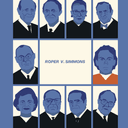National Law Journal
April 26, 2004
Editorial
By Vivian Berger
Special to The National Law Journal; Vivian Berger, an NLJ columnist, is a professor emerita at Columbia Law School.
Virtually alone among nations, the United States puts to death juvenile killers-youths who were less than 18 years old at the time of their crimes, putting us in the dubious international company of Iran and the Congo.
The U.S. Supreme Court has granted certiorari for next term to Roper v. Simmons, allowing the court to revisit whether the death penalty for juveniles violates the Eighth Amendment. […]
By a 5 – 4 margin, the Supreme Court declined to prohibit such executions in Stanford v. Kentucky [1989], a consolidated case involving defendants who had murdered at the ages of 16 and 17. The legal landscape has changed in some relevant ways since then, affording hope that Simmons will end what Justice John Paul Stevens, dissenting in In re Stanford, called a “shameful practice.“
The high court has issued two pronouncements on the subject of juvenile executions: Stanford, dealing with older teens, and Thompson v. Oklahoma [1988], dealing with a 15-year-old. In Thompson, the court held that the challenged sentence was unconstitutional; the present Eighth Amendment line has been drawn at 16 years of age.
For a long time, the Supreme Court has determined whether a practice is cruel and unusual by looking to the “evolving standards of decency that mark the progress of a maturing society.” Its members have, however, divided over the proper scope of this inquiry. Stevens, writing for the Thompson plurality, took into account not only pertinent legislative enactments and the actions of sentencing juries [deemed relevant by all of the justices], but also the views of professional and religious bodies and international opinion.
The Stevens group stressed, too, that the court must make its own judgment whether, in the circumstances before it, a death sentence does not measurably contribute to the acceptable goals of capital punishment: retribution and deterrence. Applying this approach, Stevens found that contemporary standards barred imposing death on 15-year-olds. He considered, for example, that in the 18 states with capital statutes setting minimum ages, all drew the line above the age of 15, and juries very rarely sentenced such young defendants to death. Also, numerous respected organizations and other nations had rejected the death penalty for juveniles. Finally, the immaturity, greater impulsiveness and vulnerability of adolescents reduce both their culpability and their capacity to think about the long-range consequences of their actions.
Justice Antonin Scalia’s dissent in Thompson prescribed a much narrower inquiry, limited to a statutory head count and an inspection of jury verdicts. In Stanford, Scalia, writing for the court, upheld the juvenile death penalty for teenagers older than 15; he relied almost solely on the fact that a majority of capital states countenanced their execution.
The tide turned with ‘Atkins’
This is where matters stood until Atkins v. Virginia [2002], finding execution of the mentally retarded unconstitutional. Stevens’ majority opinion, joined by all but justices Scalia, Thomas and Rehnquist, resurrected the broader Thompson methodology; it cited not only legislative changes since 1989 and the rarity of such executions, but looked to “social and professional consensus” and world sentiment. How might Atkins affect Roper v. Simmons? Even more states [31] than in the Atkins analysis [30] immunize youths from the death penalty, and, as in Atkins, their execution is highly infrequent. As with the mentally retarded, many groups and countries repudiate capital punishment for juveniles. Finally, deterrence and retribution are equally inapplicable to both groups because of their lesser ability to reason, think ahead and control their conduct.
Yet it is by no means sure that the four justices on record as ready to overrule Stanford can gain the necessary fifth vote; certiorari was, after all, granted at the state’s behest. By this time next year we will know the answer.
National Law Journal


